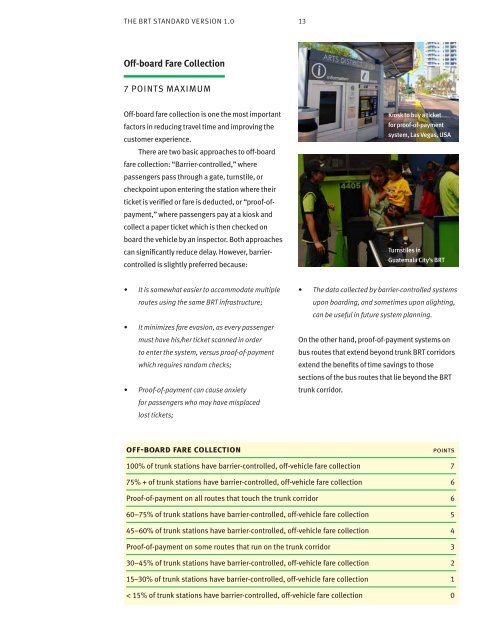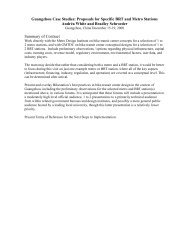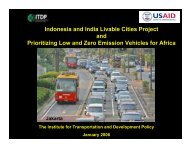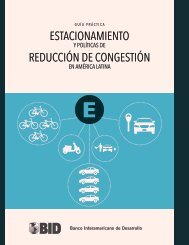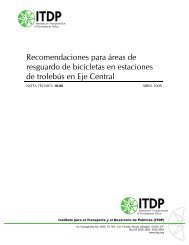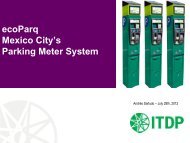BRT Standard - ITDP | Institute for Transportation and Development ...
BRT Standard - ITDP | Institute for Transportation and Development ...
BRT Standard - ITDP | Institute for Transportation and Development ...
You also want an ePaper? Increase the reach of your titles
YUMPU automatically turns print PDFs into web optimized ePapers that Google loves.
The <strong>BRT</strong> <strong>St<strong>and</strong>ard</strong> Version 1.0 13<br />
Off-board Fare Collection<br />
7 points maximum<br />
Off-board fare collection is one the most important<br />
factors in reducing travel time <strong>and</strong> improving the<br />
customer experience.<br />
There are two basic approaches to off-board<br />
fare collection: “Barrier-controlled,” where<br />
passengers pass through a gate, turnstile, or<br />
checkpoint upon entering the station where their<br />
ticket is verified or fare is deducted, or “proof-ofpayment,”<br />
where passengers pay at a kiosk <strong>and</strong><br />
collect a paper ticket which is then checked on<br />
board the vehicle by an inspector. Both approaches<br />
can significantly reduce delay. However, barriercontrolled<br />
is slightly preferred because:<br />
Kiosk to buy a ticket<br />
<strong>for</strong> proof-of-payment<br />
system, Las Vegas, USA<br />
Turnstiles in<br />
Guatemala City’s <strong>BRT</strong><br />
• It is somewhat easier to accommodate multiple<br />
routes using the same <strong>BRT</strong> infrastructure;<br />
• It minimizes fare evasion, as every passenger<br />
must have his/her ticket scanned in order<br />
to enter the system, versus proof-of-payment<br />
which requires r<strong>and</strong>om checks;<br />
• Proof-of-payment can cause anxiety<br />
<strong>for</strong> passengers who may have misplaced<br />
lost tickets;<br />
• The data collected by barrier-controlled systems<br />
upon boarding, <strong>and</strong> sometimes upon alighting,<br />
can be useful in future system planning.<br />
On the other h<strong>and</strong>, proof-of-payment systems on<br />
bus routes that extend beyond trunk <strong>BRT</strong> corridors<br />
extend the benefits of time savings to those<br />
sections of the bus routes that lie beyond the <strong>BRT</strong><br />
trunk corridor.<br />
off-board fare collection<br />
points<br />
100% of trunk stations have barrier-controlled, off-vehicle fare collection 7<br />
75% + of trunk stations have barrier-controlled, off-vehicle fare collection 6<br />
Proof-of-payment on all routes that touch the trunk corridor 6<br />
60 – 75% of trunk stations have barrier-controlled, off-vehicle fare collection 5<br />
45 – 60% of trunk stations have barrier-controlled, off-vehicle fare collection 4<br />
Proof-of-payment on some routes that run on the trunk corridor 3<br />
30 – 45% of trunk stations have barrier-controlled, off-vehicle fare collection 2<br />
15–30% of trunk stations have barrier-controlled, off-vehicle fare collection 1<br />
< 15% of trunk stations have barrier-controlled, off-vehicle fare collection 0


